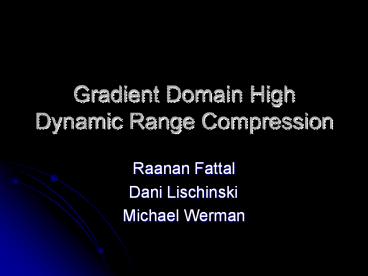Gradient%20Domain%20High%20Dynamic%20Range%20Compression - PowerPoint PPT Presentation
Title:
Gradient%20Domain%20High%20Dynamic%20Range%20Compression
Description:
Gradient Domain High Dynamic Range Compression. Raanan Fattal ... The set of different resolution images composes a Gaussian pyramid. Creating the Final Image ... – PowerPoint PPT presentation
Number of Views:156
Avg rating:3.0/5.0
Title: Gradient%20Domain%20High%20Dynamic%20Range%20Compression
1
Gradient Domain High Dynamic Range Compression
- Raanan Fattal
- Dani Lischinski
- Michael Werman
2
The Dynamic Range Problem
- Whats wrong with these images?
- What would your eye see?
- How could you put all this information into one
image?
3
Whole Image Solutions
- Tone Reproduction Curves
- Re-mapping of luminance values
- Easy to compute
- Suffer from quantization
- Examples
- Linear scaling
- Gamma correction
- More sophisticated models
4
Ward Larson Model
- One of the best total image methods
- Based on models of display capabilities and human
vision - Still suffers from loss of local contrast
- Notice washed-out appearance of the outside area
5
Local Solutions
- Tone Reproduction Operators
- Take local context into account
- Attempt to solve the local contrast problem
- Older Methods
- Based on estimating illuminance and reflectance
for each part of the image - Suffer from artifacts, dark halos
6
Low Curvature Image Simplifier
- Tumblin and Turk, 1999
- Scale luminance of smoothed image
- Add back details
- 8 parameters
- Computationally intensive
7
Gradient Domain Method
8
Basic Assumptions
- The eye responds more to local intensity
differences than global illumination - A HDR image must have some large magnitude
gradients - Fine details consist only of smaller magnitude
gradients
9
Basic Method
- Take the log of the luminances
- Calculate the gradient at each point
- Scale the magnitudes of the gradients with a
progressive scaling function (Large magnitudes
are scaled down more than small magnitudes) - Re-integrate the gradients and invert the log to
get the final image
10
1D Example
- Original Signal F(x) - Dynamic range 24151
11
1D Example
- ln F(x)
12
1D Example
- F(x)
13
1D Example
- G(x) F(x) after applying the attenuating
function
14
1D Example
- I(x) Integrate G(x)
15
1D Example
- eI(x) - New dynamic range 7.51
16
Changes for 2D
- Use gradients instead of derivatives
- May produce a non-integrable vector field after
scaling - Transform scaled vectors into a conservative
field whose gradients are closest to G(x)
17
Attenuation Map
18
Attenuation Details
- Images contain edges at multiple levels of detail
- How do we handle this?
- Compute gradients for many different resolutions
of the image - The set of different resolution images composes a
Gaussian pyramid
19
Creating the Final Image
- How do we recombine the different resolution
levels? - Start with coarsest image
- Calculate scaling factors
- Linearly interpolate those factors for each point
in the next image, and multiply with the local
scaling factor - Apply the combined factors to the highest
resolution image
20
The Attenuation Function
- a average gradient magnitude for each level
times 0.1 - ß adjustable gain (between 0.8 and 0.9)
21
Performance
- On an 1800 MHz Pentium 4
- Computing a 512x384 image takes 1.1 seconds
- Computing a 1024x768 image takes 4.5 seconds
- LCIS takes 8.5 minutes to compute a 751x1130 image
22
Examples
- Streetlight on a foggy night
- Dynamic range 100,0001
23
Examples
- Stanford Memorial Church
- DR 250,0001
24
Applications
- Enhancing contrast for LDR images
- Combining photographs of different exposure
levels to enhance detail or stitch together for
panoramas - Medical image enhancements
25
Panoramas
26
Medical Imaging
27
Questions / Credits
- Any questions?
- All pictures in this presentation are from the
original paper































